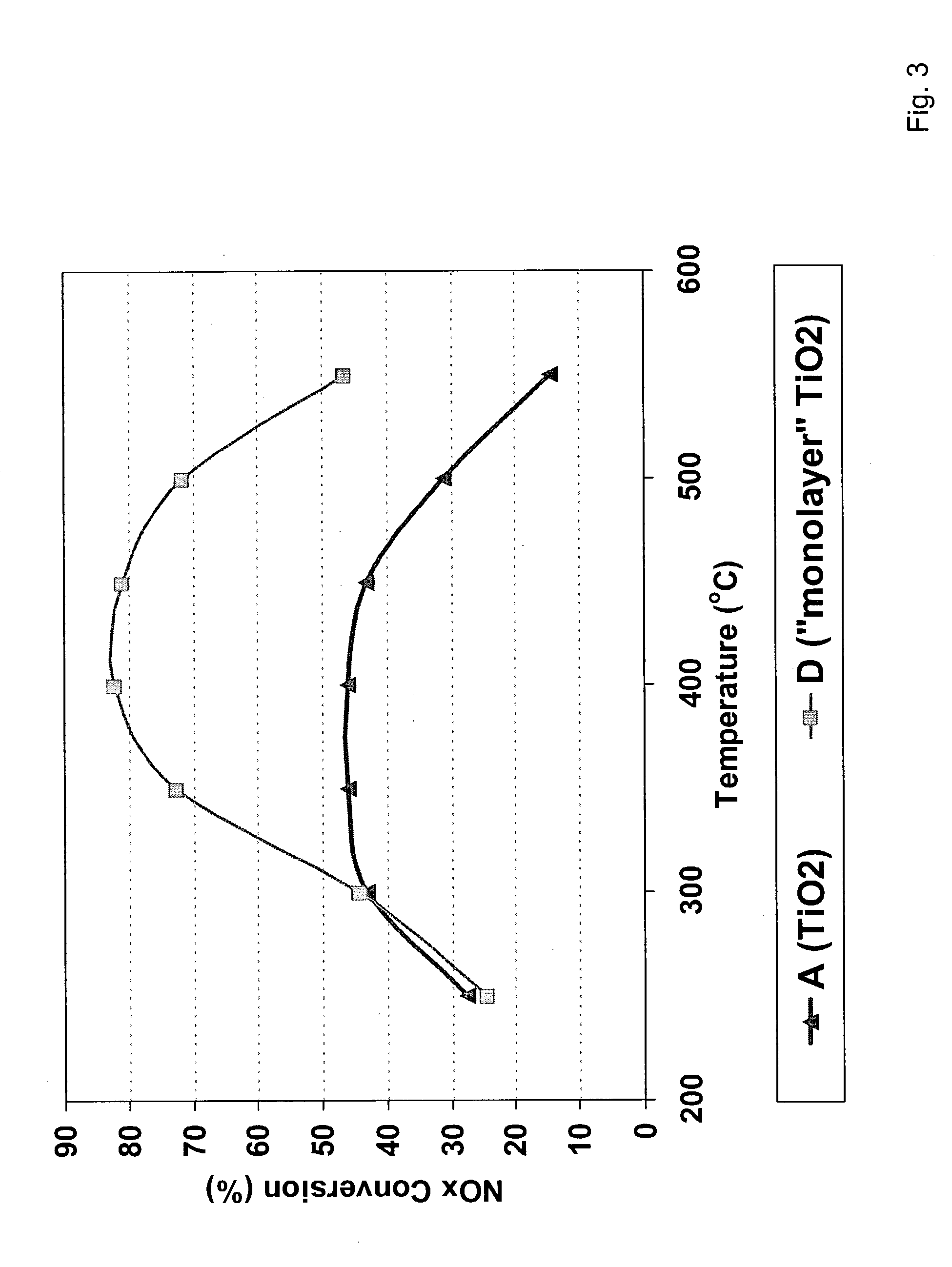Catalyst support
a technology of catalysts and supports, applied in physical/chemical process catalysts, metal/metal-oxide/metal-hydroxide catalysts, separation processes, etc., to achieve the effect of high efficiency and thermal durability
- Summary
- Abstract
- Description
- Claims
- Application Information
AI Technical Summary
Benefits of technology
Problems solved by technology
Method used
Image
Examples
example 2
[0040] Four catalyst formulations were prepared with the ingredients shown in Table I. In each formulation, the alumina was gamma-alumina having a surface area of 150 m.sup.2 / g. Catalyst "D" was formulated using the catalyst support of the invention as set forth in Example 1 wherein the titania content was 6 wt. %. Zirconyl acetate was also added during the milling process as a binder.
[0041] The procedure for preparing the catalysts was that set forth above. The NO.sub.x storage component was incorporated in each catalyst by post-dipping of the catalyst followed by calcination.
1 TABLE I Amounts in g / in.sup.3 Ingredient A B C D Bottom Coat TiO.sub.2 2 1 Al.sub.2O.sub.3 1 1.25 CeO.sub.2--ZeO.sub.2*0.5 Cat. Support of Ex. 12 (6 wt. % TiO.sub.2 on alumina) Zr-Acetate 0.05 0.05 0.08 La-Nitrate 0.05 Ba-Acetate 0.15 Platinum 0.0174 0.0174 0.0347 0.0174 Palladium 0.0868 0.0868 0.0868 Top Coat TiO.sub.2 2 1 Al.sub.2O.sub.3 1 1.75 CeO.sub.2--ZeO.sub.2*0.25 Cat. Support of Ex. 12 (6 wt. % TiO....
example 3
[0044] Catalysts A and D, formulated with the ingredients set forth in Table I, were evaluated for thermal stability. Each catalyst was aged in steam / air at 750.degree. C. for 12 hours. Thereafter, the percentage of NO.sub.x conversion was measured at temperatures ranging from about 250 to. 550.degree. C.
[0045] The results of this evaluation are shown graphically in FIG. 3. FIG. 3 shows that catalyst D containing the catalyst support of the invention has excellent thermal stability over the entire range of typical catalyst operation temperatures as compared to catalyst A that contains titanium dioxide only.
example 4
[0046] In this example, catalyst E containing the catalyst support of the invention wherein the titanium dioxide content of the monomolecular layer was 10% was compared to catalyst F wherein the catalyst support was solely gamma-alumina.
[0047] Catalyst Preparation for Catalyst E:
[0048] The bottom layer of the catalyst consisted of 75 g / ft.sup.3 Pt, 0.42 g / in.sup.3 BaO, 1.83 g / in.sup.3 TiO.sub.2-modified Al.sub.2O.sub.3 support and 0.05 g / in.sup.3 ZrO.sub.2, wherein the TiO.sub.2-modified Al.sub.2O.sub.3 support was prepared by the CVD method so as to allow 10% TiO.sub.2 by weight coverage on the surface of the alumina. The TiO.sub.2-modified Al.sub.2O.sub.3 support material was impregnated with a Pt-amine salt solution to achieve the desired loading. The resultant powder was then milled to 90% of the particles below 10 micrometers (d90<10.mu.). The milling process, which requires the addition of water to the powder, resulted in a high-solids content slurry. Barium acetate was dissol...
PUM
| Property | Measurement | Unit |
|---|---|---|
| thickness | aaaaa | aaaaa |
| temperatures | aaaaa | aaaaa |
| specific surface area | aaaaa | aaaaa |
Abstract
Description
Claims
Application Information
 Login to View More
Login to View More - R&D
- Intellectual Property
- Life Sciences
- Materials
- Tech Scout
- Unparalleled Data Quality
- Higher Quality Content
- 60% Fewer Hallucinations
Browse by: Latest US Patents, China's latest patents, Technical Efficacy Thesaurus, Application Domain, Technology Topic, Popular Technical Reports.
© 2025 PatSnap. All rights reserved.Legal|Privacy policy|Modern Slavery Act Transparency Statement|Sitemap|About US| Contact US: help@patsnap.com



